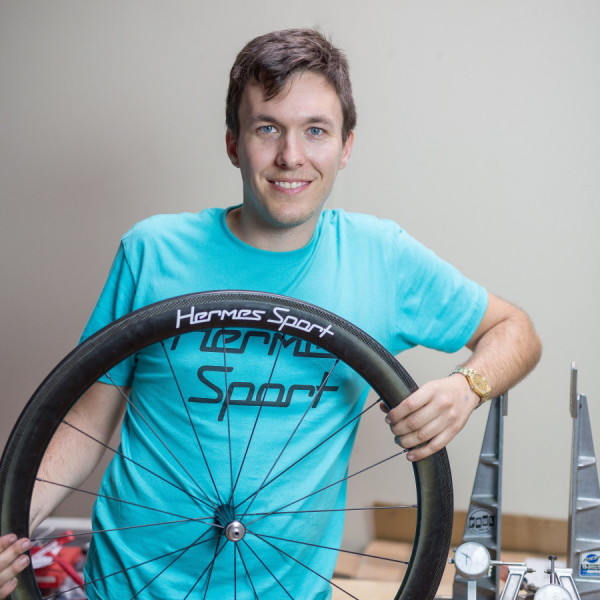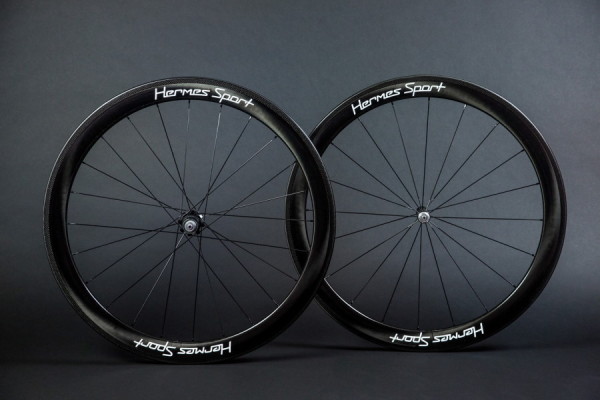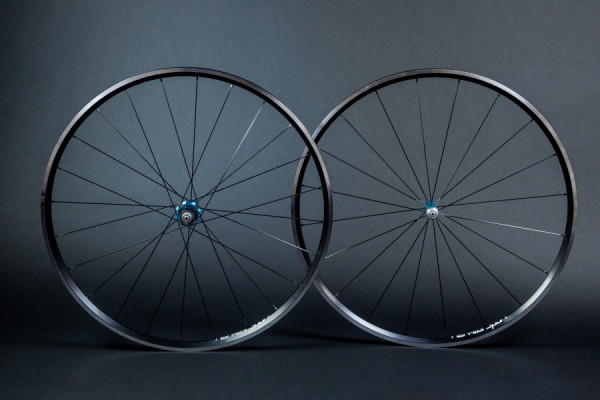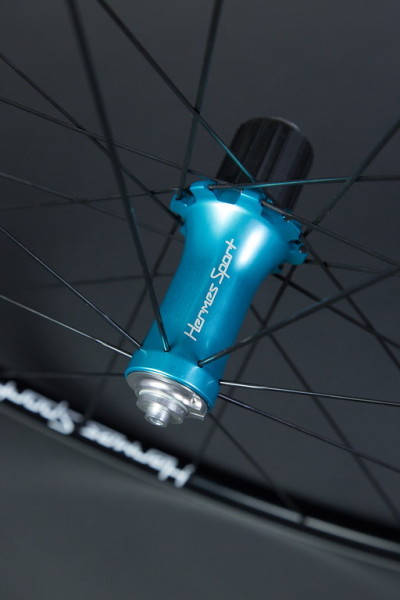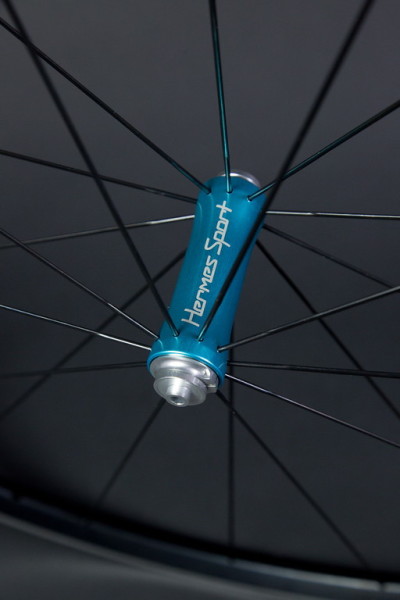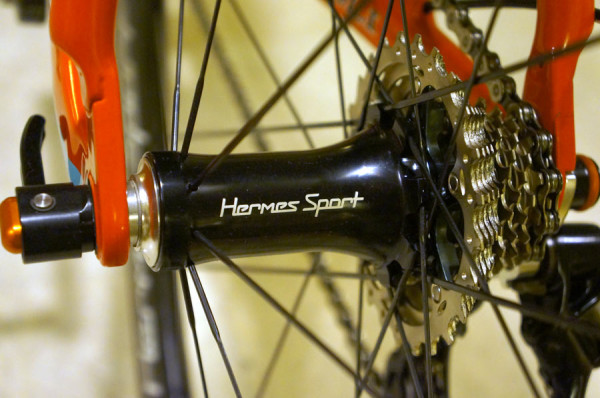After years building custom wheels for one-off customers and small batch production partners, Alex Webster, founder of Hermes Sports, found himself limited by what he perceived to be a performance ceiling in the product he could make using existing hardware. From his years of industry exposure and experience in wheel-building, and with the help of an engineer friend, Alex has spent the last three years developing and testing the VK wheel system from the ground-up, and it’s finally on shelves and ready for consumers. And, according to Alex, the wheelset delivers on the road.
But an innovative new product isn’t the whole story. In parallel with the development and testing process for these wheels, Alex has worked to establish a domestic manufacturing network for his proprietary parts, as well as setting up assembly facility in downtown San Diego. For Alex, Hermes is not just an opportunity to produce the wheels he wants to ride and to see in the world, but it’s an opportunity to stimulate and support the local and domestic manufacturing infrastructure…
BIKERUMOR: Where are you based out of?
ALEX: I’m based out of downtown San Diego. We started in Los Angeles back in ‘09. I moved down here in 2011. I’ve been enjoying it ever since.
BIKERUMOR: How did you get into bikes professionally?
ALEX: Started when I was a kid. My inspiration to make bike parts started in the 90’s with all the CNC mountain bike firms that would be making hubs and stems and cranks and brakes and everything. You could look in all these catalogs and there were a million people making everything and it was all so cool. When I was really young that was an obsession of mine, pouring through the Adrenaline Bikes catalog. I worked in a shop when I was in college. I learned how to build wheels there.
BIKERUMOR: What did you do for college?
ALEX: I went to UC Santa Barbara- my chief engineer is an old school friend of mine. The way our design process kind of goes is- I’m the one that is more acquainted with what people are riding and what they need. I’ve been working with wheels long enough to know how to accomplish that. Basically, we bounce the ideas back and forth and he’s the one with the know-how to turn it into a product that will hold up.
BIKERUMOR: That’s interesting that you have that outsider’s perspective.
ALEX: He’s a rider too, a big downhill guy, but he doesn’t work in the industry- not in any capacity other than working with me. Yeah, it’s been a really productive partnership. The VK wheels- we’ve had them in testing for almost a year now and we’re just getting them on the shelves and they behave wonderfully. So yeah, it’s on the up and up.
BIKERUMOR: You started at a bike shop, you learn how to build wheels in a bike shop. When did you know you wanted to turn that into a business?
ALEX: Around 2009 when the economy tanked. With a film degree, I knew I wouldn’t be getting much work. It was my other marketable skill. It was a funny transition, but I’ve been a buyer at this shop so I had an idea about how distribution worked. I kinda jumped into it with both feet and filled in the gaps from there.
BIKERUMOR: So initially you were doing just custom builds?
ALEX: Initially, I had a product line I was doing where I was building up Tune hubs to various rims. Did that for a while, and it gradually became a custom thing, all the while I was trying to change gears in the beginning of 2012 when I started working on this project. I would do custom wheel builds for just various frame builders. I’ve done wheels for Calfee, Firefly- a whole bunch of people like that. And also doing production runs of wheels for people. 2012, we started working on the VK program, and when we were designing it-
BIKERUMOR: Why did you feel like you needed to design this wheel system?
ALEX: The main thing is that I was running up against the limits against how good of a wheel I could make with parts off the shelf. We were building with a bunch of different brands of hubs, but at the end of the day we could only make wheels that were only so different from each other. One of our big philosophies is that the hub is a very important factor in determining how the wheel behaves. I could get into more technical mumbo-jumbo about it, but basically starting from the hub- that’s what we wanted to look at.
Based off of what we had available to us, there wasn’t really that much in the way of difference from brand to brand. Everybody kind of had variations on a theme of one or two different systems. Everyone had very similar flange geometry because you had to have J-bend spokes and a safety margin built in to accommodate the elbow of the spoke, and so working with that for a long time, we were getting bored with the sameness of everything. We were feeling like there were ways we could push things to make wheels better. And that’s what pushed us into the system wheelset design.
BIKERUMOR: You started this project in 2012… and you didn’t debut until 2014…
ALEX: And we’re only getting them onto shelves now. It was a design thing but also the challenging of finding people domestically to make the stuff for us.
BIKERUMOR: Why is that so difficult?
ALEX: Well, everyone is kind of spoiled with the kind of margins that the department of Defense pays, so it’s a little bit tough for the bike business to make it work affordably. Aside from that, just the usual getting it done on time, on spec, and on price.
I don’t want to make it sound like some horrible thing. It is a worthwhile pursuit. Ultimately, the solution is going to be to move production in-house. Now, our big project is to get a CNC lathe with live tooling and all the fixins necessary to make the hubs in house. That’s going to be the next big thing. In the meantime, I’m being an asset to local and domestic manufacturing.
BIKERUMOR: How big is your operation?
ALEX: Right now, I handle all the business aspects of it and I still do the quality control of the wheels myself. I’ve got a wheel assembler and a couple of builders that come in. It’s a bit tough to call how big it’s going to be with the new wheels. The interest overseas has been very strong, we’ve been looking to build up domestic sales too. We’ve managed to set up distribution in the UK, in China, in Australia and in Japan. So right now, just kind of off of interest we’ve been able to generate abroad, things are really looking like they are going to blow up for us. Breaking the domestic thing- that’s going to take a bit more work.
BIKERUMOR: So what is the benefit of the VK system over what you were producing before?
ALEX: What was immediately apparent was how much better they took corners than anything I’d built before. A large portion of what we had spent was in proving the interface from the hub to the rim and the individual parts of the hub to each other. That meant starting with spacing the spokes out really wide, using the off-center rear rim and the special lacing pattern, and then moving into the hub with the oversized bearings and axles- big 20mm axle and really big angular contact bearings. It’s a lot of little technologies that add up to the principal thing that is the strength to weight is fantastic and it was the handling that was the first thing that really jumped out at me… like whoa. Going down descents and on flat ground and then just the pedaling response in every regard- it’s been a just fantastically stiff system.
BIKERUMOR: Backing up a little bit- I’m interested in your testing. It sounds like you do a lot of ride testing. Back with the custom wheels and even now, how are you determining that your custom wheels were behaving similarly?
ALEX: It was something that we didn’t really have to tell from testing. You could tell just from looking at the specifications of the hubs. You would have these very small- there are a couple of very important metrics that determine how the hub is going to perform. One is the size of the axle, size of the bearing. The other is the flange spacing and the bracing angle that gives you. And ultimately if two hubs have the same size axle and the same bracing angle, those are the two main things that are – they are going to behave very similarly. If you put up the hubs that were really popular around 2012 or 2002… they are the same as they are now, they don’t change very often. You’re looking at a couple millimeters here and there. People are either using 15mm or 17mm axles. It was from looking at that and knowing the hubs would be similar. It was going from that and working the engineering ideas behind it to try to come up with something that would behave differently. It was more of a proving of engineering ideas that we had rather than an iterative process where it’s like, okay, let’s test this and that, this and that.
No, it was something that looked good on paper and delivered on the road… without sounding too pleased with myself…
BIKERUMOR: So it wasn’t a massively iterative process.
ALEX: No. We knew how we wanted to accomplish in the design and it delivered.
BIKERUMOR: It’s interesting how some technology doesn’t significantly change in the industry year to year, or even decade to decade.
ALEX: There’s been very little rocking the boat in hubs since the 90’s. You have a few things here or there but ultimately, with rare exceptions, people are mostly making things similar to the way they were back then.
BIKERUMOR: But your engagement system is an exception. Can you talk about that?
ALEX: Yeah. So that’s actually something we licensed from a company in Europe. The attraction with that… ha ha, cause it’s magnet driven… it has two magnets that push apart from one another instead of a spring. There is a ratchet ring that’s toothed, and that has a magnet that’s pushed into the back of it and another one flipped around pushing into the hubshell. That repelling force pushes the ring into contact with the freehub. It makes it so that there are no pawls, there are no springs, there’s only one moving part in the whole operation. And since the teeth are so big and engaged against such a large area of the hubshell, you don’t have to have any separate inserts. There’s nothing funny like that.
It’s just as simple as a freehub can be, but at the same time it’s very resilient and kind of does what a freehub needs to do without any real complaining. It demands hardly any servicing.
BIKERUMOR: Was that one of the goals in taking on that technology?
ALEX: It was an ease of life kind of thing. One of the guiding principles was that we wanted to do something new and clever but at the same time we didn’t want it to be just a millstone to deal with. So we’ve made the adjustment and the maintenance really easy across the board and the freehub was part of that. Like, oh man, it’s so easy to take apart and work on. Nothing will fly out of the hub at you when you try to take it apart. Part of it was making it easy to live with, but it was so elegantly simple that in and of itself, it had built in appeal.
BIKERUMOR: So it’s on the shelves now… with teal hubs.
ALEX: I didn’t want to do the whole spread in black, blue, red, yadda yadda. Kind of blase. In any production run, most hubs will be black, maybe a quarter of them will be done in a color of my choosing. Maybe off the wall like my Jamaica teal, as I call my first color. But once they are gone, I may never do that color again. I would love to, every time I do a round of hubs, do a different color or pattern that we’ve never done before.
BIKERUMOR: Is that because of the Adrenaline Bikes catalog?
ALEX: There is a little bit of the 90’s kid in me always wanting things in turquoise and purple. There is a little of that. There is a little joie de vivre that I want to keep going. A lot of that 90’s stuff didn’t work, but people seemed to have fun making it. I want to keep that vibe alive to the best of my ability.
BIKERUMOR: I definitely sympathize. I want to talk more about the technology of that wheelset. Like the asymmetry in your hubs.
ALEX: That was something that kind of came from me from building wheels. It was a pattern that I really liked. Basically, I’m not going to claim that I’m the only one that does it. Campy does it. It was really great because it accomplished a lot of things at once. It put more spokes in the back. It put more spokes where there is more stress on the drive side. The drive side – the torque goes through those spokes. They do a lot of the support of the rider at a disadvantage because they don’t have the same bracing angle as the non-drive side due to the dish. It was great because it really let us get rid of a weak spot in the wheel that we would have had otherwise. I’m a big believer in high tension for spokes. There are a few things that it does for the wheels that are really good, and that lacing pattern let us do that.
BIKERUMOR: So what do you do with the rims that allows you to produce that high tension?
ALEX: Everything has to be drilled at a precise angle so that there is no interference with the spoke nipple entering the rim. There can be no kink coming out of the rim. It demanded, especially the way we were doing it where we were pushing it really far out, it demanded a proprietary rim. That was the other part of what was pushing us into doing system stuff. One, we wanted to get away from doing j-bend spokes, and two, we wanted to do the lacing the way we wanted to without having to deal with the hubs and the rims that were out there.
BIKERUMOR: I would imagine a thicker spoke bed would be advantageous.
ALEX: And we do a thicker spoke as well. Instead of a CX ray with 2.015mm wide spoke that gets hammered into a blade, we use spokes from MACH 1 in France- they’ve got a bit more meat on them. All the spokes are more efficiently employed in taking up the load that the wheel’s going to see from pedaling, from handling the weight of the rider, from cornering- it’s a really efficient arrangement of material and at 1450g, it’s yielded a really fantastically stiff and strong platform.
BIKERUMOR: Is that your aluminum wheelset?
ALEX: My aluminum and the VK51 carbon clinchers weigh the same. The tubulars weigh less, but through an interesting coincidence, the clinchers ended up weighing the same.
BIKERUMOR: So this is all crazy ambitious.
ALEX: Yes, I guess so!
BIKERUMOR: To go from a small custom and OE operation to this.
ALEX: And now moving into machining and all that. It’s a big, crazy thing. It’s a total distraction. It’s a complete lifestyle. It’s very much a 10-12 hour a day kind of undertaking, six days a week. I get up to ride whenever I can, but otherwise it’s just work work work. But at the same time, the enthusiasm of doing all these projects and now, especially that we’re turning them into something that’s going to be a viable proposition, is really exciting. It does keep me going every morning. You do go to bed tired.
BIKERUMOR: I bet! You can just put this within the context of doing a full wheel system on its own is a massive undertaking, even for a wheel company with a team working on it. But to do it from scratch and keep it domestic while working on your own manufacturing facility- that’s crazy! What kind of advice would you give someone who thinks they want to do this?
ALEX: I mean, I would say: don’t be afraid to do something ambitious. The harder the project you set for yourself, if it makes sense, the better the chance you have of it succeeding because then you’ve got something that fewer other people have got. It’s tough, but it has its own rewards built in because you’re already separating yourself from the pack. That would really be my one piece of advice. Avoid taking the easy way out.
BIKERUMOR: Before I forget! How do you ride when you actually have time to ride these days?
ALEX: When I do ride I do road and mountain. When I was first starting out I worked for Niner- a bit of outrageous nepotism on the part of my cousin, Fuzzy John Mylne, [who] wrangled me a job at Niner when I was just starting out in 2009. That turned into a single speed mountain bike obsession. So I’m either riding the Interbike tradeshow queen, or I’m riding my $400 aluminum single speed no-name frankenbike. If you’re in San Diego, you might catch me dicking around in Balboa Park just on my way to work. I’d like to get on the velodrome here, but I’ve got to get some stuff squared away before then. I don’t make any mountain bike stuff at the moment, but that’s not to say that I’m not enthusiastic about it.
BIKERUMOR: If you’re riding it, you’re thinking about it.
ALEX: With the mountain bike thing, when a good idea comes to me I’ll be inclined to pursue it. With mountain biking, it’s a question of making a meaningful difference in mountain bike wheels like I did with road. It’ll come to me at some point. When it does, I’ll be prepared to jump on it. Right now it’s still percolating.
BIKERUMOR: Building product around an argument rather than a price point.
ALEX: That was really it – not to do something just to do it. That’d be another piece of advice. Have a point. Be ambitious and have a point.
